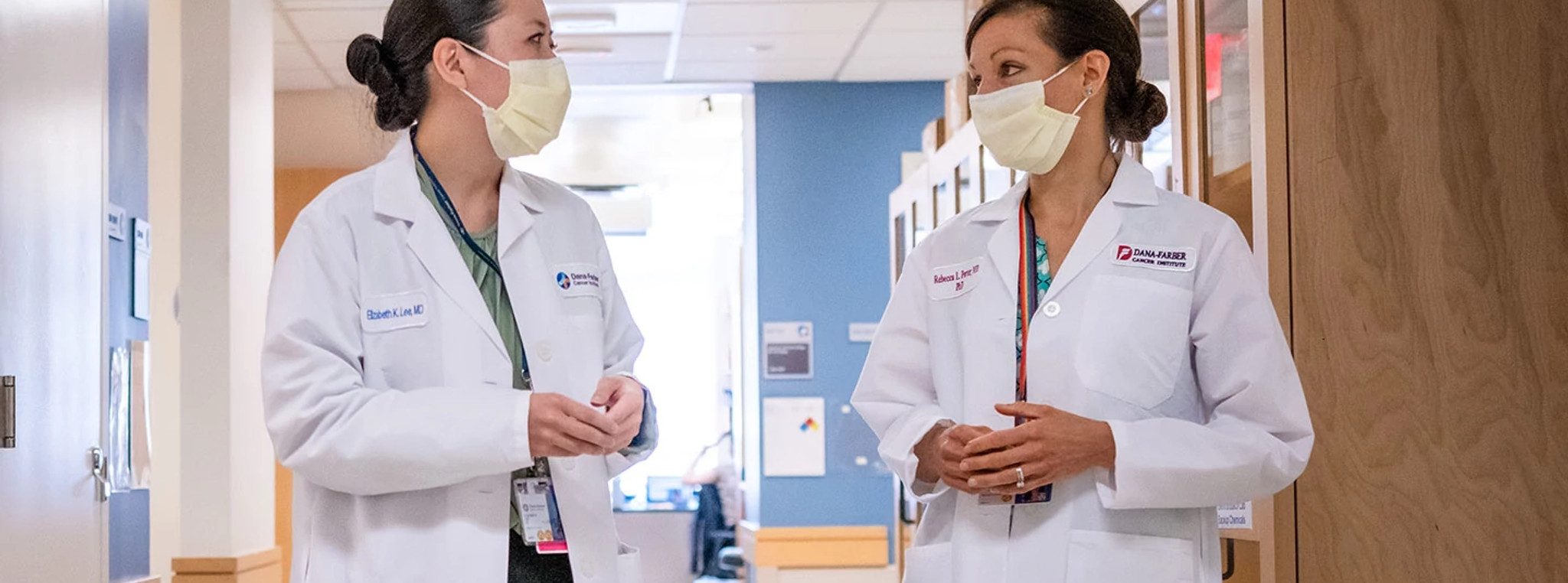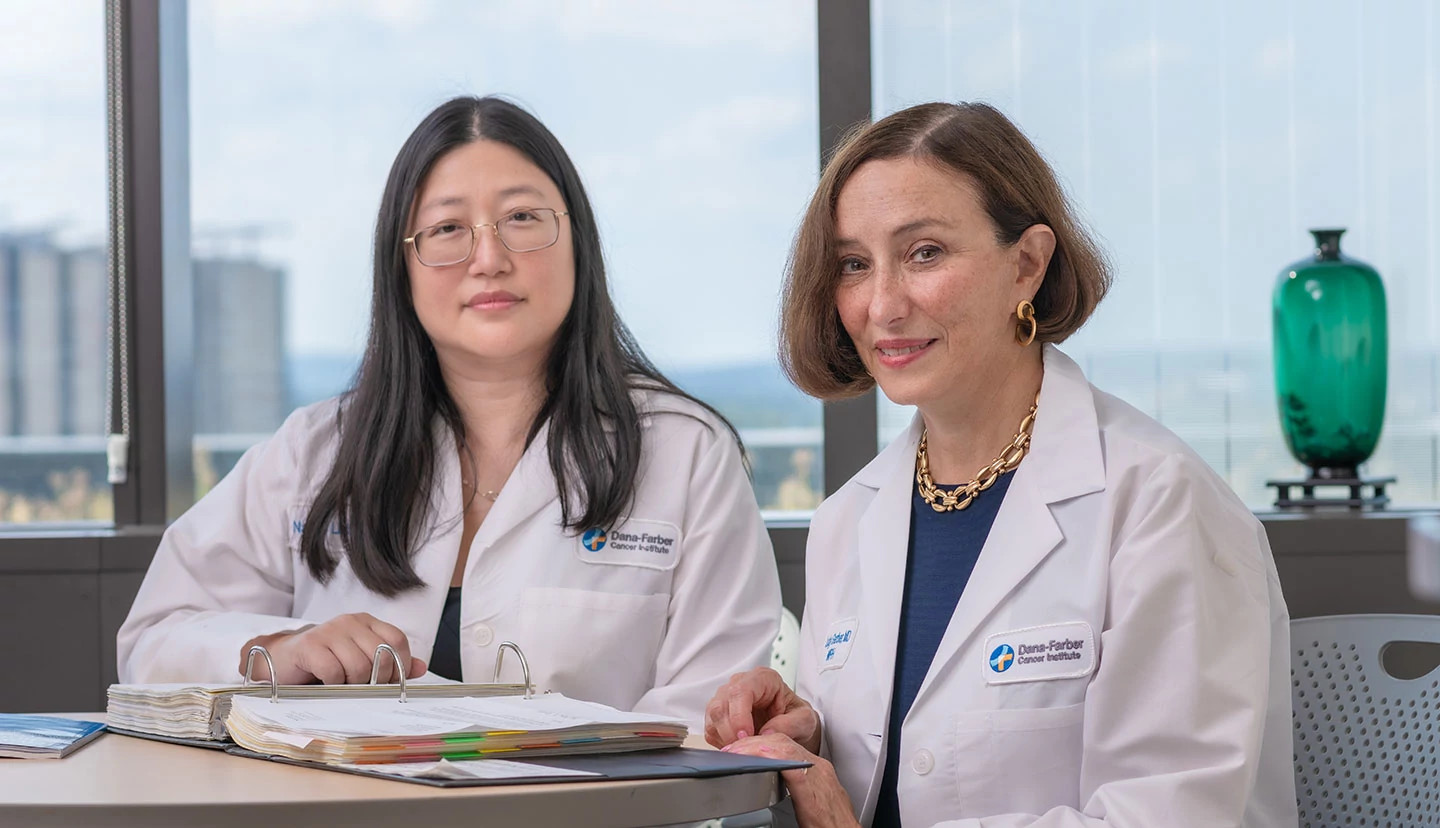
Clinical Trials Help Advance the Frontiers of Treatment
November 22, 2021
Research
Ian E Krop
Susan F. Smith Center
Gynecologic Cancer
Cancer Genetics
Breast Cancer
By Nicole Davis, PhD
Clinical trials are a linchpin of modern medical research. By rigorously studying how new drugs and treatment regimens work in patients – addressing key questions about safety and effectiveness – the medical community can bring the most promising new approaches to the clinic. Such work is vital for driving progress in all areas of medicine.
Dana-Farber's Susan F. Smith Center for Women's Cancers leads hundreds of clinical trials annually. Numerous trials, as well as clinical studies, which include patients but do not intervene in or change their care, are now underway to improve critical aspects of breast, ovarian, and uterine cancer treatment. Although this past year presented significant challenges as the coronavirus pandemic raged on, many trials remained open.
"The pandemic forced us to come up with some creative solutions, like delivering investigational oral medicines to clinical trial patients through the mail and conducting some visits via telehealth," says Sara Tolaney, MD, MPH, associate director of the Susan F. Smith Center, chief, Division of Breast Oncology. "It was a big lesson for the community – and one that, if carried forward, could help make trials more broadly accessible and convenient for patients in the future."
Several clinical trials and studies are now afoot that aim to improve treatment, especially for the most difficult-to-treat breast and gynecologic cancers, and to make progress toward two long-sought goals in cancer medicine: early detection and prevention.
Expanding Treatments for Uterine and Ovarian Cancers

Uterine cancers represent the sixth-leading cause of cancer deaths for women in the United States. "These cancers are also among the few cancer subtypes that are increasing in both frequency and mortality, so they signify an area of very high unmet need," explains Joyce Liu, MD, MPH, who serves as director of clinical research and is associate chief of the Division of Gynecologic Oncology at Dana-Farber.
For the last several years, Liu and her colleagues have been studying adavosertib, an experimental drug that interferes with how cells sense and respond to DNA damage. She and her team recently published the results of an investigator-initiated phase 2 trial, which showed that roughly 30% of patients with an aggressive form of uterine cancer (known as uterine serous carcinoma) saw their tumors shrink following treatment with adavosertib. All told, about half of patients' tumors stopped growing.
Dr. Liu's group has expanded her initial trial to include a translational research component to shed light on adavosertib's biology and the molecular mechanisms that underlie its effectiveness in this cancer subtype. In addition to this trial, Dr. Liu is the principal investigator of an international, multi-site phase 2 trial that is also underway. "The science behind why adavosertib works in these tumors – what specifically makes them vulnerable – will also help guide us in figuring out what other cancer subtypes might benefit from the drug," said Liu.
Medical oncologist Elizabeth Lee, MD, is also leading a clinical trial that includes gynecological cancers, specifically those that are positive for HER2, a key protein that helps drive cancer growth. Over the last two decades, a variety of HER2-targeted therapies have been developed, including trastuzumab deruxtecan, or T-DXd, which was recently approved by the FDA for patients with advanced forms of HER-2-positive breast cancer. T-DXd consists of two molecular components: trastuzumab, an antibody, which recognizes and neutralizes HER-2, and deruxtecan, a highly potent chemotherapy drug. These elements are chemically linked together, forming a kind of smart bomb that can deliver chemotherapy directly to HER2-positive tumor cells.
Now, Dr. Lee and her colleagues are studying whether T-DXd, in combination with another molecularly targeted drug called olaparib, can benefit patients with advanced forms of HER-2-positive cancers, including breast, ovarian, and uterine cancer. The team is conducting a phase 1 trial that is sponsored by the National Cancer Institute (NCI) that will explore the safety and dosing of the drug combination. While it is still too early to know whether these drugs will prove effective, Dr. Lee is hopeful.
"The hope is that we'll be able provide more treatment options for patients and fit into the standard of care," said Dr. Lee. "There are a variety of gynecological cancers that express HER2, and our goal is to take advantage of that molecular vulnerability."
Rebecca Porter, MD, PhD, another medical oncologist within the Division of Gynecologic Oncology at Dana-Farber, is leading a clinical trial that seeks to test a new molecularly targeted inhibitor against the ATR protein in certain forms of ovarian cancer. A first-generation version of this inhibitor showed promise when combined with chemotherapy in certain ovarian cancers that are resistant to standard treatment. This work, led by Panos Konstantinopoulos, MD, PhD, director of Translational Research in Gynecologic Oncology at the Susan F. Smith Center, was published in The Lancet Oncology last year and has paved the way for a phase 3 clinical trial.
Now, Dr. Porter and her colleagues are testing a selective ATR inhibitor that is designed to be more potent, which could allow chemotherapy to be used at a lower dose in the combination therapy. A phase 1 trial has been launched to evaluate safety and dosing of this new inhibitor (known as elimusertib) together with the chemotherapy drug, gemcitabine.
"For most ovarian cancers, the question is not really if they'll recur, but unfortunately when," said Dr. Porter. "And when it does, the cancer becomes more of a chronic disease that we try to hold at bay with sequential, but unfortunately often less effective, therapies. So, what's desperately needed are drugs that can either prevent recurrence or better target treatment-resistant tumor cells."

Overcoming Hurdles in Breast Cancer Treatment
Historically, most clinical trials in breast cancer have excluded patients whose disease has spread to the brain yet included patients whose tumors have advanced to other sites, like the liver. The concern is that patients with worsening disease in the brain represent a very challenging group when it comes to treatment, and their inclusion might impact the trial's results. Consequently, there are few, if any, treatment options for patients with breast cancer that has progressed to the brain.
"This is a real problem, particularly for breast cancer patients with HER2-positive disease," said Nancy Lin, MD, a breast oncologist and the associate chief of the Division of Breast Oncology at the Susan F. Smith Center. "Half of these patients will eventually develop brain metastases over their lifetime. So, if we exclude them, we aren't really testing the drug in a population that is truly representative of the disease."
Dr. Lin is one of the trailblazers solving this problem. She has helped create a roadmap for researchers on how to formulate clinical trials that include patients with brain metastases. In addition, she's driving innovation in treatment through a variety of clinical trials that test whether novel drugs and drug combinations are effective in breast cancer patients with brain metastases.
Over the last several years, Dr. Lin and her colleagues, including breast oncologist Rachel Freedman, MD, MPH, have shown that different HER2 inhibitors – first lapatinib and later neratinib – can cause brain tumors to shrink in patients with advanced HER2-positive breast cancer when combined with an oral chemotherapy drug. "That was really the starting point for a proof-of-concept that systemic, targeted therapies can work in the brains of breast cancer patients," said Dr. Lin.
A pillar of the team's work is their close collaboration with research scientists, especially Dana-Farber investigator Jean Zhao, PhD, whose lab specializes in developing mouse models that more closely resemble human breast cancers and can reliably predict whether or not drugs will be active in the brain in humans.
Motivated by studies in Zhao's animal models that showed the effectiveness of neratinib, in combination with another HER2-targeted drug called T-DM1, Dr. Freedman is now leading a phase 2 clinical trial of this drug pair in breast cancer patients with brain metastases. She and her colleagues hope to have results next year.
"Women are living longer with metastatic breast cancer, which means brain metastases could become more common," says Dr. Freedman. "So, figuring out ways to help this group of patients is really critical."
Most recently, Dr. Lin's group has helped analyze the effects of a new HER2-blocking drug, called tucatinib, in combination with Herceptin, the first HER2 inhibitor to be developed, together with chemotherapy. Known as the HER-2CLIMB trial, this effort led to the FDA approval of tucatinib in April 2020 for certain patients with advanced HER2-positive breast cancer. Importantly, the trial showed that the triplet therapy could not only shrink tumors in the brain and delay progression, but also significantly improve survival. "These are patients who for many years have essentially been written off because they have a poor prognosis," says Dr. Lin. "We've shown that it is possible to develop therapies that significantly extend the survival of these patients. Now, we as a community must do it."
Together with Dr. Zhao and other collaborators, Dr. Lin is already leading the charge. Her team is now testing a new drug, called GDC-084, that targets two key cell signaling pathways at once, in combination with Herceptin. They are also launching a clinical trial of the HER2 smart bomb T-DXd, (the same drug Dr. Lee is studying in combination with olaparib). They will examine how well the drug works in breast tumors that have spread to the brain.
While metastatic disease poses treatment challenges, so too does ensuring that cancers do not return once they have been eradicated. This is especially true in some inherited forms of breast cancer caused by mutations in the BRCA1 and BRCA2 genes. But breast oncologist Judy Garber, MD, MPH, is searching for new options to help protect these patients from cancer recurrence.
Dr. Garber and her colleagues recently published the results of an international phase 3 clinical trial that examined the use of the PARP inhibitor olaparib as an adjuvant therapy in patients with early-stage breast cancer caused by the BRCA genes. (Adjuvant therapy is typically administered after the surgical removal of the tumor.) Known as the OlympiA trial, it involved more than 1,800 patients from 420 centers across 23 countries and showed that olaparib can significantly improve disease-free survival when administered to patients for a full year following standard treatment.
"We are delighted to be able to show that the PARP inhibitor had an important effect in patients around the world with breast cancers because of their BRCA1 or BRCA2 gene mutations," said Dr. Garber, who is chief of the Division of Cancer Genetics and Prevention and a medical oncologist in the Breast Oncology Center at Dana-Farber. "It also means we now have a reason to genetically test more patients when they are diagnosed with breast cancer, so we can determine who might benefit from this treatment."
Improving Early Cancer Detection and Prevention

While finding new treatments is a major focus of the Susan F. Smith Center, there is also a deep commitment to discovering ways to find tumors earlier – and even prevent them altogether. Early detection often means better outcomes for patients, particularly those who are at high risk of developing cancer due to the genes they carry. Dana-Farber's Dipanjan Chowdhury, PhD, is leading a clinical study that seeks to develop an early diagnostic test for ovarian cancer.
Known as the MiDE study (MicroRNA Detection study), Dr. Chowdhury and his colleagues are collecting blood from individuals who carry genes, including BRCA1 and BRCA2, that increase their risk of ovarian cancer. They analyze these blood samples with a specific focus on a subset of small molecules called microRNAs. Dr. Chowdhury's team discovered and validated a specific microRNA pattern that is associated with a high risk of ovarian cancer. Now, they are testing whether this molecular pattern can help predict whether a woman with a high genetic risk of ovarian cancer will go on to develop the disease.
"Removing the ovaries has a major impact not just on fertility, but also on overall health risk, so the anxiety that many of these patients live with day-to-day is just extraordinary," says Dr. Chowdhury, who is chief of Radiation and Genome Stability and co-director of Dana-Farber's Center for BRCA and Related Genes. "A test that can reliably tell women if they are going to develop ovarian cancer would be an enormous benefit."
At the same time, Dr. Garber and her colleagues are examining the role of denosumab, a drug that blocks a protein called RANK ligand. Early research showed that blocking this protein in mice with mutations in BRCA1 can prevent the animals from developing breast cancer. Now, Dr. Garber and her colleagues are launching an international phase 3 trial to test denosumab in patients who carry mutations in the BRCA1 gene.
"At this time, we can only reduce cancer risk with surgery," said Dr. Garber. "This clinical trial is a major undertaking that will help us understand if a medication can reduce breast cancer risk in women at very high genetic risk, and perhaps allow them to at least delay preventive surgery."
The trial, which will run in seven countries, including the U.S., seeks to enroll over 2,900 patients. Denosumab is an FDA-approved drug already used by doctors to treat osteoporosis and prevent bone metastases in cancer patients.
"A common thread that unites these studies is finding more personalized treatments that are tailored to patients' own disease biology," said Ian Krop, MD, PhD, associate division chief of the Breast Oncology Program in the Susan F. Smith Center. "When we can tailor therapy better, patients do better – and that's really what our work is all about."